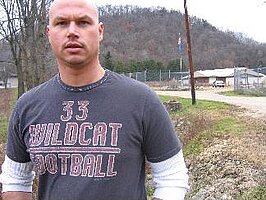Mercury accumulation in Chironomus dilutus reared on nutrient-limited food

Dan McEwen is a PhD Student in Biological Sciences
North Dakota State University
Fargo , ND 58105-5517
Email: daniel.mcewen@ndsu.edu
BA, Biology (2003) Minnesota State University - Moorhead
Fellow: Daniel C. McEwen, Department of Biological Sciences, NDSU
Advisor: Malcolm G. Butler, Professor of Zoology, NDSU
Matching Support : NDSU
Degree Progress : Ph.D. expected in May 2008
Mercury accumulation in Chironomus dilutus reared on nutrient-limited food
he accumulation of mercury in aquatic ecosystems is an international problem that is exacerbated by anthropogenic influences. Mercury damages the central nervous system of animals, altering the way that nerves conduct electrical impulses and divide, leading to lowered cognitive and mental functioning or, in especially acute circumstances in humans, cerebral palsy, mental retardation or death. Its effects are especially harmful to fetuses or infants during development of the nervous system. Mercury emissions have continued to increase since the industrial revolution, and presently, approximately 2/3 comes from industrial emissions. The primary conduit through which humans acquire mercury is eating contaminated fish. As of 2002, 48 states in the United States had issued consumption advisories for selected lakes and rivers for concentrations in fish between 0.2-0.5 ppm of mercury while 28 had general statewide advisories. As a result, the United States EPA and various state agencies issue advisories for fish consumption where impairment occurs. The North Dakota Department of Health currently has consumption advisories listed for Devils Lake, Red River, Lake Oahe, Missouri River, Lake Sakakawea, and other waterbodies. Due to the wide-spread dissemination of mercury, its toxicity to humans and wildlife, and its rate of increase, continued research is warranted. I have proposed to research the dynamics of transference of mercury into a common fish prey item, Chironomus dilutus, under various nutrient regimes. We can then model the potential impact of mercury accumulation on fish feeding on these and similar invertebrates.
Objectives and Methods:
A mass culture will be maintained by feeding 2 mg ground Tetramin B every third day. Once adults emerge, the water surface will be checked daily for egg masses, which will be immediately extracted and held in a glass beaker until the eggs hatch. One first instar larva will be transferred by pipette to each of 6 wells in culture plates (model Costar 3506) containing 0.5 g diatomaceous earth and 5 ml dechloronated water. Rearing of individual larvae will occur in a diurnal growth chamber (series 101 Percival Scientific, Inc.) set for 16:8 (L:D) at 23 oC. Animals will be fed with dried Scenedesmus that will be cultured in MPI media modified to contain a phosphorus-limited (C:N:P 400:100:1), nitrogen-limited (C:N:P 50:5:1), and a nutrient-balanced (C:N:P 102:26:1) condition relative to the average stoichiometric signature of Chironomidae (C:N:P 152:26:1). Mercury will be introduced as HgCl 3 at concentrations of 0, 0.5, and 1.0 ug ml -1. Cultures will be fed at low and high food levels of 3 mg/larva/day and 6 mg/larva/day. At day 20, the chironomids will be harvested and transferred to clean dechloronated water for 24 hr to allow for the purging of gut contents. Larvae will then be dried at 105 oC for 24 hours. Six larvae from each replicate plate will be pooled and ground with a mortar and pestle. Approximately 2 mg of sample will be sent to the Colorado Stable Isotope laboratory for C:N analysis with mass spectrophotometry; 2 mg will be used to analyze phosphorus using the ascorbic-acid molybdate procedure (APHA 1992), and the remaining sample (~30 mg) will be sent to the Archaeometry Laboratory, University of Minnesota-Duluth for methyl-mercury analysis using an acid digestion followed by cold vapor atomic absorption spectrometry. Each treatment will have 5 replicates where the experimental unit will be one culture plate holding six larvae. Model selection procedures will be used to determine the best model, using mercury concentration and growth as dependent variables and combinations of nutrient regime, mercury concentration, and food amount as predictors.
Project Progress:
A culture of Scenedesmus obliquus (TOW 9/21 P-1W) has been obtained from an unnamed pond in Itasca State Park, Minnesota (from M.W. Fawley). Chironomus dilutus culture has been established with larvae from a regional wetland, with culture methods adapted from Townsend et al. (1979). Preliminary growth experiments are in progress, using a high nutrient food source (i.e., Tetramin B) to determine methodology for maintaining cultures and sustaining low mortality. We are also in the process of growing batch cultures of algae at desired nutrient levels to feed Chironomus. We anticipate final results by January 1, 2008.
Significance of Research:
This research will provide a better understanding of factors contributing to the bioaccumulation of mercury in aquatic ecosystems. Information derived from this study will be made available in dissertation format and through publication in referred journals. Findings will be presented at national scientific conferences including meetings of the North American Benthological Society.

Melcolm Butler
Biological Sciences
Office: Research 2, Room 214B
Phone: 701-231-7398
Email: malcolm.butler@ndsu.edu


